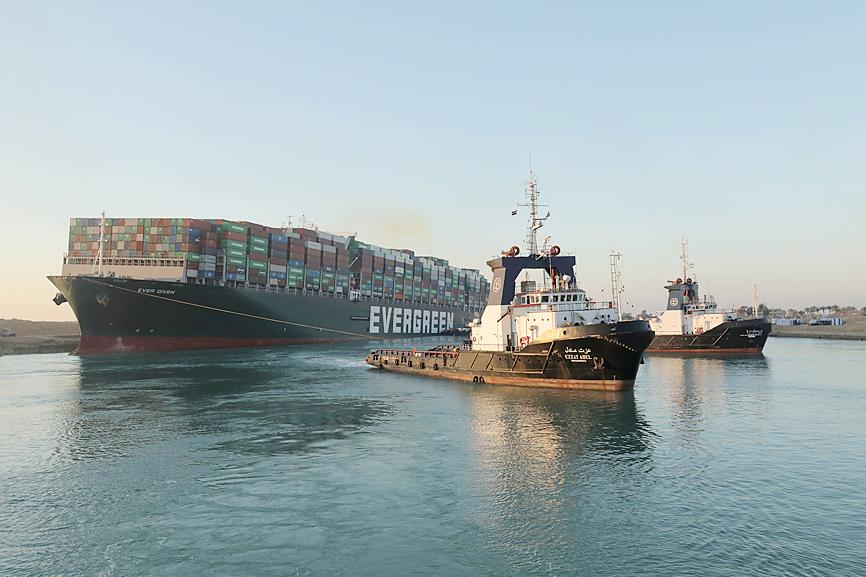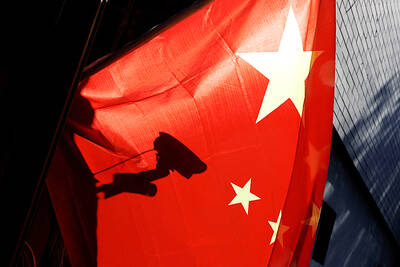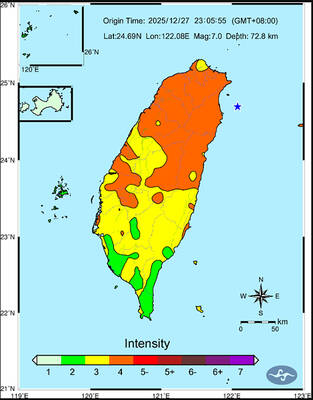Salvage teams yesterday set free a colossal container ship that has halted global trade through the Suez Canal, a canal services firm said, bringing an end to a crisis that for nearly a week clogged one of the world’s most vital maritime arteries.
Helped by the peak of high tide, a flotilla of tugboats managed to wrench the bulbous bow of the skyscraper-sized MV Ever Given from the canal’s sandy bank, where it had been firmly lodged since Tuesday last week.
After hauling the fully laden vessel over the canal bank, the salvage team was pulling the vessel toward the Great Bitter Lake, a wide stretch of water halfway between the north and south end of the canal, where the ship was to undergo a technical inspection, canal authorities said.

Photo: Reuters
Satellite data from MarineTraffic.com confirmed that the ship was moving away from the shoreline toward the center of the artery.
Video released by the Suez Canal Authority showed the Ever Given being escorted by the tugboats that helped free it, each sounding off their horns in celebration after nearly a week of chaos.
The obstruction has created a massive traffic jam in the vital passage, holding up US$9 billion each day in global trade and straining supply chains already burdened by the COVID-19 pandemic.
It remained unclear when traffic through the canal would return to normal. At least 367 vessels, carrying everything from crude oil to cattle, have piled up at either end of the canal, waiting to pass.
Data firm Refinitiv estimated it could take more than 10 days to clear the backlog of ships.
Meanwhile, dozens of vessels have opted for the alternate route around the Cape of Good Hope at Africa’s southern tip — a 5,000km detour that adds about two weeks to journeys, and costs ships hundreds of thousands of dollars in fuel and other costs.
The freeing of the vessel came after dredgers vacuumed up sand and mud from the vessel’s bow, and 10 tugboats pushed and pulled the vessel for five days, managing to partially refloat it at dawn.
It was not clear whether the Ever Given, a Panama-flagged, Japanese-owned ship leased by Taiwanese company Evergreen Marine Corp (長榮海運), which was hauling goods from Asia to Europe, would continue to its original destination of Rotterdam, Netherlands, or if it would need to enter another port for repairs.
Ship operators did not offer a time line for the reopening of the crucial canal, which carries more than 10 percent of global trade, including 7 percent of the world’s oil. More then 19,000 ships passed through last year.
Millions of barrels of oil and liquefied natural gas flow through the artery from the Persian Gulf to Europe and North America.
The unprecedented shutdown had threatened to disrupt oil and gas shipments to Europe from the Middle East, and raised fears of extended delays, goods shortages and rising costs for consumers.
The salvage operation successfully relied on tugs and dredgers alone, allowing authorities to avoid the far more complex and lengthy task of lightening the vessel by offloading its 20,000 containers.

A magnitude 7.0 earthquake struck off Yilan at 11:05pm yesterday, the Central Weather Administration (CWA) said. The epicenter was located at sea, about 32.3km east of Yilan County Hall, at a depth of 72.8km, CWA data showed There were no immediate reports of damage. The intensity of the quake, which gauges the actual effect of a seismic event, measured 4 in Yilan County area on Taiwan’s seven-tier intensity scale, the data showed. It measured 4 in other parts of eastern, northern and central Taiwan as well as Tainan, and 3 in Kaohsiung and Pingtung County, and 2 in Lienchiang and Penghu counties and 1

FOREIGN INTERFERENCE: Beijing would likely intensify public opinion warfare in next year’s local elections to prevent Lai from getting re-elected, the ‘Yomiuri Shimbun’ said Internal documents from a Chinese artificial intelligence (AI) company indicated that China has been using the technology to intervene in foreign elections, including propaganda targeting Taiwan’s local elections next year and presidential elections in 2028, a Japanese newspaper reported yesterday. The Institute of National Security of Vanderbilt University obtained nearly 400 pages of documents from GoLaxy, a company with ties to the Chinese government, and found evidence that it had apparently deployed sophisticated, AI-driven propaganda campaigns in Hong Kong and Taiwan to shape public opinion, the Yomiuri Shimbun reported. GoLaxy provides insights, situation analysis and public opinion-shaping technology by conducting network surveillance

‘POLITICAL GAME’: DPP lawmakers said the motion would not meet the legislative threshold needed, and accused the KMT and the TPP of trivializing the Constitution The Legislative Yuan yesterday approved a motion to initiate impeachment proceedings against President William Lai (賴清德), saying he had undermined Taiwan’s constitutional order and democracy. The motion was approved 61-50 by lawmakers from the main opposition Chinese Nationalist Party (KMT) and the smaller Taiwan People’s Party (TPP), who together hold a legislative majority. Under the motion, a roll call vote for impeachment would be held on May 19 next year, after various hearings are held and Lai is given the chance to defend himself. The move came after Lai on Monday last week did not promulgate an amendment passed by the legislature that

AFTERMATH: The Taipei City Government said it received 39 minor incident reports including gas leaks, water leaks and outages, and a damaged traffic signal A magnitude 7.0 earthquake struck off Taiwan’s northeastern coast late on Saturday, producing only two major aftershocks as of yesterday noon, the Central Weather Administration (CWA) said. The limited aftershocks contrast with last year’s major earthquake in Hualien County, as Saturday’s earthquake occurred at a greater depth in a subduction zone. Saturday’s earthquake struck at 11:05pm, with its hypocenter about 32.3km east of Yilan County Hall, at a depth of 72.8km. Shaking was felt in 17 administrative regions north of Tainan and in eastern Taiwan, reaching intensity level 4 on Taiwan’s seven-tier seismic scale, the CWA said. In Hualien, the